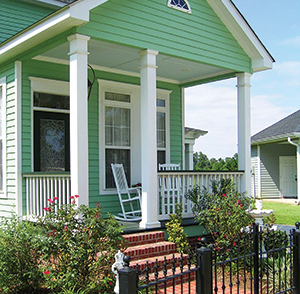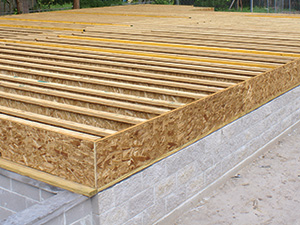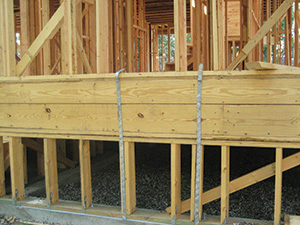 A raised wood floor system is an assembly of beams and girders, floor joists, and plywood or oriented strand board (OSB) floor sheathing, all properly sized, connected together and placed on a foundation. A raised wood floor system is designed to elevate the living space off the ground, isolating it from moisture and pests. American homes have been built on raised wood floor systems since Colonial times, and the aesthetic and practical reasons for building a raised home still apply today.
A raised wood floor system is an assembly of beams and girders, floor joists, and plywood or oriented strand board (OSB) floor sheathing, all properly sized, connected together and placed on a foundation. A raised wood floor system is designed to elevate the living space off the ground, isolating it from moisture and pests. American homes have been built on raised wood floor systems since Colonial times, and the aesthetic and practical reasons for building a raised home still apply today.
Many terms are frequently used to describe raised floor systems in different regions of the country. Examples include raised wood floor, off-grade floor, pier-and-beam foundation and crawlspace construction. Regardless of the exact term or construction method used, a raised wood floor system provides numerous advantages.
See Raised Wood Floor Case Studies.
Types of raised wood floor foundation systems
A solid foundation is the most important part of a new home. A raised wood floor can be supported by a variety of foundation types (several are presented below). Always check the local building code for specific foundation requirements. Regardless of the foundation system used, the foundation and the footings must be of adequate size and strength to support the design loads. Once the foundation is in place, a system of beams and girders, floor joists, and plywood or oriented strand board (OSB) floor sheathing, is installed to complete the raised wood floor.
 Pier-and-beam foundation
Pier-and-beam foundation
A builder has several options for constructing piers when building a pier-and-beam foundation. The piers can rest on spot footings or a continuous footing. The placement and spacing of the footings and the piers is determined by the location of load bearing walls and the span capabilities of the floor joists.
 Stem wall foundation
Stem wall foundation
A continuous foundation wall around the perimeter of the home. It is frequently constructed of reinforced masonry or poured concrete and supported by a continuous, reinforced-concrete footing.
 Wood stem wall foundation
Wood stem wall foundation
A continuous foundation fabricated of lumber-framed walls sheathed with structural plywood or OSB panels on top of a continuous footing. Wood stem walls reduce concrete costs, simplify leveling and are easily built on site.
 Wood pile and pier foundations
Wood pile and pier foundations
Treated wood piles and wood piers minimize or eliminate the use of concrete altogether. They are popular in coastal areas for acquiring necessary height, but can also be cost effective for raising floors just a few feet. Piles are often used in soils with low-bearing capacity.
10 Reasons to Build Raised Wood Floors
Builders who offer the raised wood floor option, framed with durable, renewable wood, create value for not only their clients, but also themselves. The construction advantages of a raised wood floor system include:
1. Costs less to build than slab-on-fill
A raised wood floor system can be a cost-competitive alternative to a concrete slab system – especially when bringing in dirt to elevate a structure is necessary.

2. Expedites scheduling of trades
Construction of a raised wood floor helps accommodate the scheduling of trades. For example, concrete and masonry work does not have to wait on plumbing installation and inspection, which is typically the case with slab foundations.
3. Speeds up construction
Concrete forming and curing is time consuming. Hauling in fill dirt and properly compacting it adds more time. Poor weather and inspections can result in lengthy concrete delays. Constructing a pier-and-beam or pile foundation, builders contend, is faster, regardless of the weather.
4. Provides more level foundations on any soil type
Raised wood floor systems may be constructed on any soil type and perform very well on problematic soils, such as expansive clays, which can crack conventional concrete slabs. While any foundation can settle, the use of piers with a raised wood floor system makes leveling or repairs simple. Repairing or leveling a cracked, damaged concrete slab can be very expensive.
5. Solves floodplains and sloping lots
Raising a slab with fill dirt to meet floodplain elevation requirements can be expensive, time consuming and difficult to properly compact. A raised wood floor system provides a practical and affordable solution for meeting code and keeping a home above flood waters. For sloped lots, a raised wood floor on piers is more economical and practical than building a “cut and fill” slab foundation. Less soil is disturbed, reducing erosion, and the piers eliminate the need for reinforced retaining walls.
6. Simplifies repairs and renovations
Installation, maintenance and modification of utilities such as water, sewer and electrical is easy and economical compared to slab systems. Routing and rerouting of wiring for electrical, telephone, television and home entertainment is more quickly accomplished. Renovating or relocating plumbing fixtures is relatively easy and less expensive.
7. Identifies the builder as green and progressive
A raised wood floor is the right choice for the environment. Wood is a renewable resource that takes far less energy to produce than concrete or steel. The latest advances in wood products and building technology help produce more durable and efficient homes.
8. Sells homes faster and for more profit
The aesthetics of a raised floor home make an impression on homebuyers. “People notice that,” says builder John Cooper of Cooper Homes. “If they don’t pay more for (the aesthetics) – which I think they do – the house will sell faster than a house that is on a slab.”
9. Matches changing consumer preferences
More and more homebuyers desire traditional style and charm but don’t want to sacrifice modern conveniences. Raised wood floors “give home owners the amenities of the present while embracing the style of the past,” says builder Dennis Collier of Collier Construction. In flood-prone areas, “people like (raised wood floors) just for peace of mind,” says builder Peter Russell of Bay Homes.
10. Reduces call-backs and liability
Strong, durable wood houses last for several generations. Furthermore, foundation access on a raised wood floor home allows many structural modifications and maintenance to be performed easily, extending the useful life of the structure. The elevated living space of a raised wood floor foundation is isolated from ground moisture, termites and pests, and is less susceptible to disruption from growing tree roots. Easy foundation access makes inspections fast.